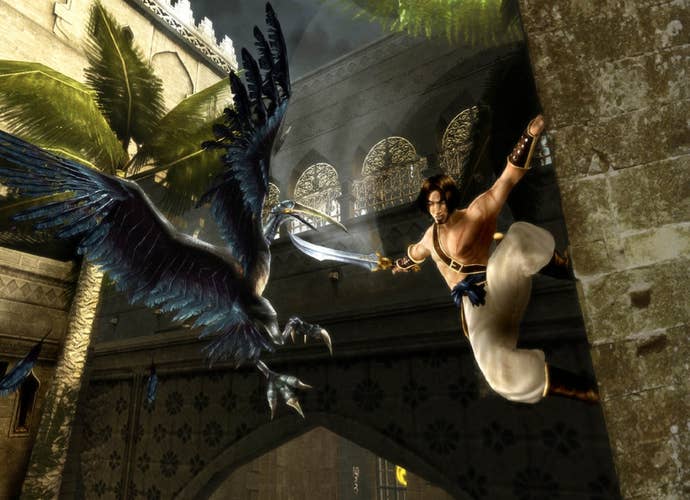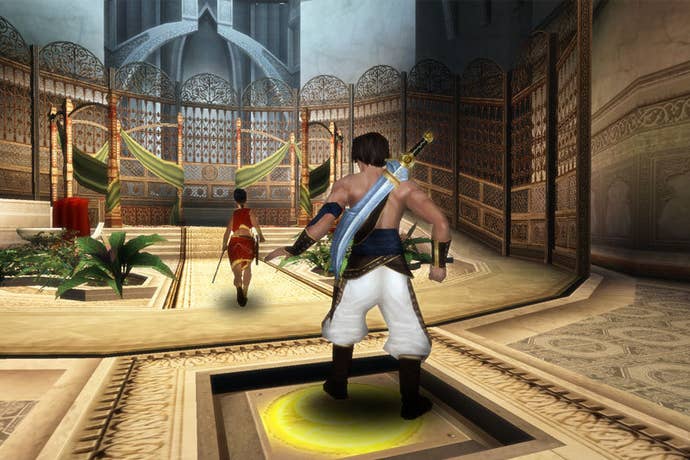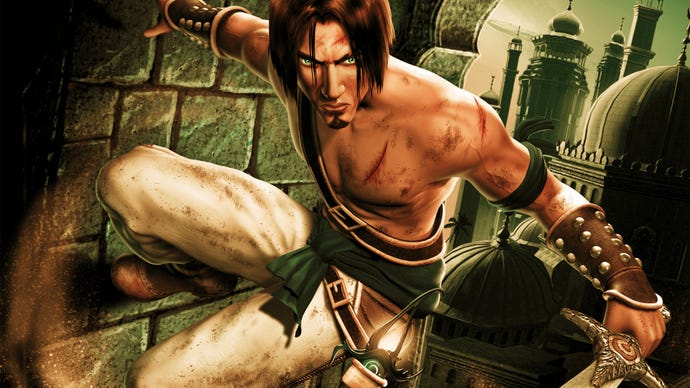20 years ago, Prince of Persia: Sands of Time proved we don’t need remakes
Rewinding back to a time when reboots were good, and necessary, and different.
No no no, that's not what happened. The idea of an entire story told in flashback has been used many times in cinema and books, definitely less so in games. But there are many ways to tell a story, so even the wrong ones might be considered. What about if the story takes a sudden turn and the main character dies? Well, he would have no other choice than to interrupt the flashback, break the fourth wall by talking directly to us and wind the story back before that untimely demise.
That was one of the fascinating narrative devices which fueled the return of the Prince of Persia series in 2003’s Sands of Time. I am here to look back at what made that return so special and still warrants a fresh playthrough, some 20 years later.
First, let us pause and go back to the late 80s. What made the original 1989 Prince of Persia special? Was it the gripping narrative? Or perhaps a faithful recreation of a palace in ancient Persia? No, those definitely would not be the right choices. Rather, they would be the high rhythm action gameplay, the incredibly smooth movement of the prince, along with the exquisite graphics. Well, for the time.
Still, let us not forget Sands of Time was not the prince’s first foray into 3D space. In 1999 Red Orb brought us Prince of Persia 3D: while mostly forgotten today, it was well received by critics as a puzzle-heavy alternative to Tomb Raider. But the public did not seem to appreciate the slow rhythm and clunky combat mechanics. In 2001, after acquiring the license to the franchise (12 years after the original’s debut), Ubisoft wondered: how can we make people care about Prince of Persia again?
Sands of Time built upon the original’s strengths, while also working on new features that would make sense for the audience of 2003. It was not going to be a simple cosmetic upgrade or jumping on the bandwagon of another successful action series. Sure, Sands of Time does feature beautiful graphics, along with smooth movement for our main character. But, after 36 months of work, the most important twist on the franchise’s tried-and-true gameplay came to be time rewinding mechanics. To think it came from a project which did not even have an art director after almost 12 months into development!

While the first few minutes seem to be a plain 3D action title, when the Prince cracks the hourglass and finally masters the time rewinding mechanic, it changes step into a different action platforming vibe altogether. Now, you can go back before meeting an untimely demise or, simply, to repeat a jump or come out of a fight with slightly more health. The game does not limit your possibilities; the rewind can be used in any situation (as long as there is enough sand, of course).
The rewinding of time was not just an ingenious gameplay mechanic, but also a central narrative motif. With a story built upon a flashback, and the idea of going back in time to warn the Princess of the Vizir’s betrayal, a wiser Prince would look back at the actions of his somewhat younger and more reckless self. The story was entirely in service of the action, as the gameplay was never paused to let the characters talk.
Original Prince of Persia creator Jordan Mechner, who served as a writer on the project, recalled how the original plot was much more complex, featuring nine different characters with opposing political factions and objectives. These ideas would eventually be dropped in favor of a simpler and stronger story, which was kept as grounded as possible and in one single location. Dropping the long narrative cutscenes, to really bolster the idea that Sands of Time was an action title first and foremost, was the directive that Mechner saw to implement first – after scrapping the original story.
Among the many creative narrative ideas, the Prince himself ended up being the one responsible for activating the traps in the palace. Basically, you just make the whole game more difficult for yourself as you play, because you blindly follow a guard’s advice. The princess, Farah, was also a second player character for a good chunk of the action. Not a simple damsel in distress, she is a true sidekick who helped by solving traps and fighting guards. The banter between the two would serve to display their respective narrative arcs and their slow-building romance – a technique that would be employed by many more Ubisoft games in the future.

Along with solid combat mechanics, a modern and exquisitely written narrative, and sweet platforming mechanics, there was a great soundtrack by Stuart Chatwood. Personally, I was always mesmerized by the closing track – “Time only Knows” – which would not have felt out of place in an epic romance drama. An aching love song which bookended the sour and aching note of longing the game concluded on that, perhaps, anticipated the dark turn for the prince which would come later.
20 years later, Sands of Time is still a tremendous lesson in bringing relevance back an early 90s platforming title. Instead of a straight remake – or a reboot which changed everything – the team decided to bring back what made Mechner’s games legendary, elevating their concepts, while still keeping them challenging for the player, both in narrative and gameplay terms. Despite the mentioned development problems, Sands of Time ended up being an unexpected success for Ubisoft and would signal the beginning of a trilogy, while also inspiring the Assassin’s Creed framework of narrative and gameplay.
One would think that such a brilliant concept and gameplay mechanics would easily translate into a clear direction for a successful series of 3D action platforming games, but… no no no, that’s not what happened. The first sequel, Warrior Within, downtuned its guitars, switched out the Arabic tunes for Godsmack, and took a sudden turn into weird out-of-place nu-metal vibes. The prince was now an anti-hero, on the run from his “dark self”. Gameplay-wise, it wasn’t terrible, but it seemed to function as a showcase of questionable design choices. Not to mention the writing which seemed to cater more to angsty teens rather than the mature audience of the previous title.

The original trilogy was completed with 2005’s The Two Thrones, which dialed back the anger to some degree, feeling like an half-assed apology: a design ret-con which ended up as a bridge between the two games. In 2008, the series came back with a self-titled retread, with less emphasis on action and fierce combat and more on a sort of poetic flow of platforming and action. Since the original trilogy’ story was completed, Ubisoft opted for yet another reboot, but this time the inspiration was clearly Ico, rather than platforming games from the MS-DOS era. While it was appreciated by critics, the public did not embrace this new poetic Prince at all, and the planned (second) trilogy never got off the ground.
The original Sands of Time was developed by a small 10 people team, which later grew to 65. It was the product of talented designers, left alone to work on something they loved while also receiving essential design and writing help from the original creator of the franchise. The result? A unique product of its time, a meeting of talents which unfortunately did not repeat for any of the subsequent games that would follow.
Given all this, it is perhaps not surprising that, as opposed to 2003, the Ubisoft of today (or well, that of 2020) opted to bring the series back with a straight remake of the original Sands of Time. Probably the one decision which made sense from a business standpoint: why risk investing on an idea which could spectacularly fail, when you can just bank on the tried and true value of nostalgia?
If anything, modern day Ubisoft, ever since the announcement, seemed to struggle in understanding what kind of message they wanted to give to the audience. Was Sands ‘20 going to be a straightforward remake or an entirely new experience, while still being faithful to the original? The answer was probably all of the above. Three years after that first announcement, the fate of the remake hangs in the balance or, perhaps we should say, frozen in time.
In what direction could a contemporary Prince of Persia title head towards to capture back its audience? Perhaps going back to the successful blueprint of Sands of Time would be a magnificent idea to start with. For example, Ubisoft could have easily imagined a metroidvania, with the Prince exploring faraway lands with rocking Arabic tunes in the background, an engrossing story enriched by tasty 2D graphics and – why not – time controlling mechanics. Could that have been the right injection of life for a franchise which, today, feels all but buried in the sand? Well, as the prince would say… “Wait, what did I just say? That didn't happen. Let me back up a bit.”
